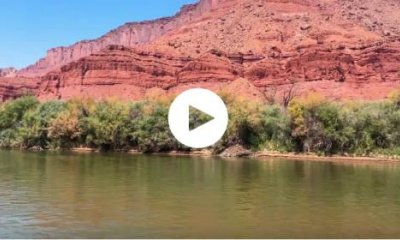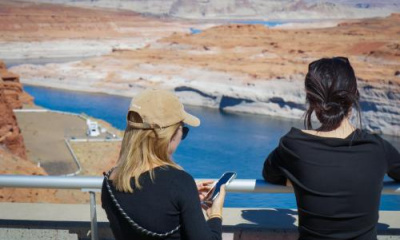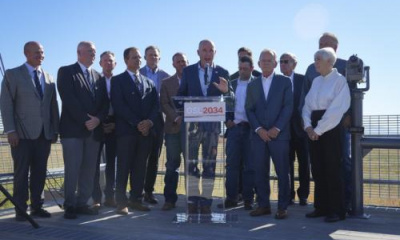As a new water years begins, officials plan next steps in the fight to save the lake
Great Salt Lake Commissioner Brian Steed and Deputy Commissioner Tim Davis had the ideal setting Wednesday for their briefing on what’s happening with the Great Salt Lake, what’s next and their hope for another good water year.
The pair were sitting at a picnic table at Antelope Island State Park under blue skies and a calm wind. The bugs, of which Great Salt Lake has many depending on the season, have mostly retired for the year and left them alone.
“This is an awesome time to visit the lake,” Steed said. “If you can get out to Antelope Island, the visitor center is closed currently for renovations, but the venue itself is spectacular. So if you have the option, that’s a welcome to all Utahns to come out to see the lake. It’s a great time to visit it.”
The levels of the north arm and the south arm of the iconic lake are within about a foot of each other, despite allowing extra water to flow from the north to the south to alleviate salinity levels that had reached levels threatening the survival of brine shrimp and an entire industry two years ago.
“It was a really scary time. We hope never to be in that sort of scary time again by adaptively managing it,” Steed said.
Both arms have since stabilized but the lake elevation needs to come up by at least another two feet to chart a path toward recovery. The fact that the two side of the lake remain in the condition they are in is a good sign, the two men added, given this time of year is typically when the lake reaches its lowest point due to evaporation and especially in light of the lack of recent precipitation.
The health of the lake depends on what happens this fall, and of course this water year, which began Monday.
“It was a really good water year and we’ve had two good water years in a row,” Steed said, adding, “That has been a real game changer for the Great Salt Lake. Unfortunately, I can’t guarantee that we have another one coming up. I mean, in my heart of hearts, I’ll tell you, I very much hope that this upcoming water year is as good as the last two of them have been in terms of what it’s done for the lake.”
The Office of the Great Salt Lake Commissioner gave a briefing to lawmakers in an interim meeting last month, detailing what was done over the last year and what is to come next.
Davis, deputy commissioner, said the office has been meeting with a variety of water entities throughout the basin to coordinate efforts, a step Davis said is critical for recovery efforts of the lake.
“So there are a number of other legislatively-created commissions, authorities within the Great Salt Lake Basin. There’s the Bear River Regional Commission, there’s the Jordan River Commission and the Utah Lake authority,” he said, to name a few.
Those groups met in September, he added.
“Within the Great Salt Lake Basin, it’s really good to coordinate our efforts, make sure that we’re communicating well, and we’re all pulling in the same direction. And it was productive for hours, and we really laid out all of our different plans, all of our different authorities, and for the first time, we’re committed to working, communicating together going forward.”
Documenting the water
Lawmakers asked the office in the next meeting to provide a list of “real” water headed to the Great Salt Lake via donations done in perpetuity or temporary leases that are subject to revocation under the terms of a contract.
Included in those offerings so far is the announcement last month by Compass Minerals that it would relinquish 205,000 acre-feet on an annual basis of nonproductive water rights. In addition, it agreed to forfeit 65,000 acre-feet of water not in production in perpetuity.
“When lake levels are high, Compass can withdraw up to its existing water right, just as they could always do – but in years with lower lake levels, they have committed to decreasing their water use — or suspending it completely if the lake reaches the critical levels we experienced several years ago,” Jamie Barnes, director of the Utah Division of Forestry, Fire and State Lands, said in a statement at the time.
Steed said to get an idea of the volume of the water, it is the equivalent of half of Deer Creek Reservoir.
The Church of Jesus Christ of Latter-day Saints also donated in perpetuity a little over 20,000 acre-feet of water in March of 2023, the Utah Department of Natural Resources reported. The church most recently donated 1,700 acre-feet of water for the benefit of the Great Salt Lake that is time limited.
In addition, Jordan Valley Water Conservancy District allotted 5,300 acre-feet of water on a time limited annual basis. Ogden City agreed to give up 1,500 acre-feet of water out of Willard Bay, but actually, 4,000 acre-feet was released to the Great Salt Lake. The First Unitarian Church of Salt Lake City announced recently it had collected $35,000 to benefit the lake via a trust set up to handle monetary and water donations for the lake.
Davis said there are other leases, and the Office of the Great Salt Lake Commissioner has been asked to quantify the amount of water, the donor and the status of the delivery — if it is in perpetuity or on a lease-basis with a time limit.
The idea is to get at exactly how water is needed, how much has been given over to the benefit of the Great Salt Lake and what that “gap” looks like, Davis said.
The leases and donations mostly have been handled through the Great Salt Lake Watershed Enhancement Trust, set up with a $40 million appropriation by Utah lawmakers. The trust is operated jointly by The Nature Conservancy and the Audubon.
Why the lake matters
Both Steed and Davis stressed despite the positive nature of this additional water, stewardship of the Great Salt Lake and ignoring its finite resources should not affect the urgency of continuing to act in a responsible manner.
“It’s going to take a change of behavior from all Utahns in the watershed. We can water our grass less outside, for those in the municipal and industrial settings, and we can be a lot more efficient how we use water in the agricultural setting,” Steed said. “Both those things are really important, and then we have to conserve, dedicate and deliver that saved water back to the lake.”
The Great Salt Lake, the largest terminal saline lake in the Western Hemisphere and the eighth largest in the world, has been under duress due to drought and over depletion. Its shrunk to half its size, leaving 800 square miles of exposed lake bed which threatens air quality along the Wasatch Front with blowing dust that contains toxins. The continuing demise of the lake threatens the millions of waterfowl that make the lake a critical stopover for nesting, feeding and resting along the Pacific Flyway.
It’s economic contributions to Utah are valued at $1.9 billion annually and it supports some of the most critical companies in the extraction industry, such as U.S. Magnesium, North America’s largest producer of magnesium — a critical mineral most people lack in their diet. Additionally, it supports a brine shrimp industry that constitutes 45% of the global supply. The natural fishery and its threats have those engaged in aquaculture worried.
Everyone close to the knowledge of the lake’s importance knows what is at stake.
Steed said he has heard conflicting opinions about what is to happen this winter, but the state climatologist is optimistic the wet pattern will continue. Steed likes that forecast.
“Oftentimes, there’s a few good years, and then they trend back into the mega drought. And there are those that are predicting that, yeah, this is just a pause in the mega drought, and we would expect to go back into that,” he said. “That is what makes me more nervous and keeps me up at night.”









